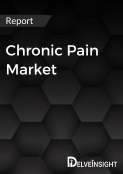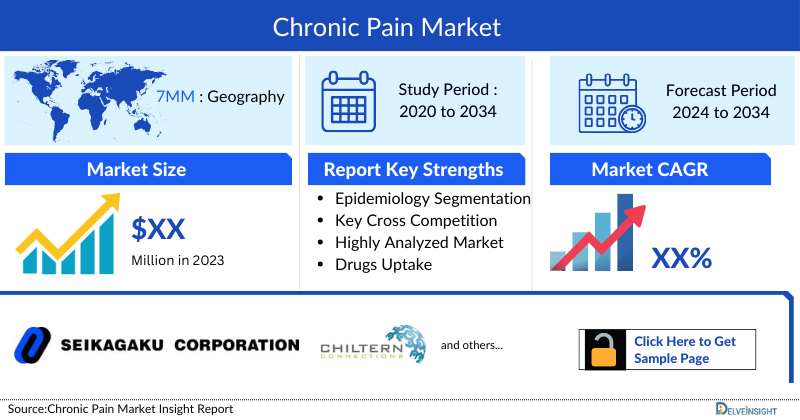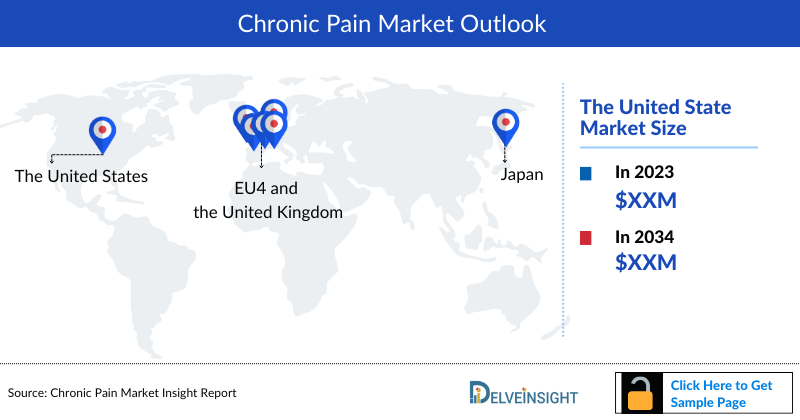Chronic Pain Market
- International Association for the Study of Pain (IASP) defines pain as an unpleasant sensory and emotional experience linked to actual or potential tissue damage.
- It can stem from injury or the brain's mishandling of pain signals. Chronic pain persists for extended periods (>3 months) and often requires ongoing treatment, ranging from mild to severe.
- Chronic pain’s common sources include low back pain, musculoskeletal pain, migraines, fibromyalgia, neuralgia, cancer pain, visceral, and post-operative pain, with many causes remaining unidentified.
- The Chronic Pain Market Size is anticipated to witness a substantial positive shift owing to better uptake of existing drugs, the expected market launch of therapies, and raised awareness.
- The United States accounts for the largest Chronic Pain Market Size, in comparison to EU4 (Germany, Spain, Italy, France), the United Kingdom, and Japan.
- There are several categories of medications that are used for the Chronic Pain Treatment, such as nonsteroidal anti-inflammatory drugs, acetaminophen, opioids, opioid-like agents, or combinations of opioids and non-narcotic analgesics, corticosteroids, antirheumatics/immunological agents, and anticonvulsants.
- Drugs approved for the Chronic Pain Treatment due to different causes include EMGALITY (galcanezumab-gnlm), TARLIGE (mirogabalin besylate), AIMOVIG (erenumab-aooe), AJOVY (fremanezumab), VYEPTI (eptinezumab), and PENNSAID Gel.
- Opioids have been the mainstay of treatment for patients experiencing moderate to severe pain, with around 168 million prescriptions written for opioids in 2018 in the US. Although in the US, the overall national opioid dispensing rate declined from 2012 to 2019, and in 2019, the dispensing rate had fallen to the lowest in the 14 years, around 46.7 prescriptions per 100 persons (total of more than 153 million opioid prescriptions). Still, opioids usage is seen in the range of 40 to 50% in the US cases in moderate to severe chronic pain.
- In 2023, among the 7MM countries, the US accounted for the most number of total Chronic Pain Prevalent Cases followed by Japan, and the UK.
Request for unlocking the sample page of the "Chronic Pain Treatment Market"
DelveInsight's “Chronic Pain Market Insights, Epidemiology and Market Forecast – 2034” report delivers an in-depth understanding of Chronic Pain, historical and forecasted epidemiology as well as the Chronic Pain market trends in the United States, EU4 (Germany, Spain, Italy, and France) and the United Kingdom, and Japan.
Chronic Pain Treatment Market Report provides real-world prescription pattern analysis, emerging drugs, market share of individual therapies, and historical and forecasted 7MM Chronic Pain market size from 2020 to 2034. The report also covers current Chronic Pain treatment market practices/algorithms and unmet medical needs to curate the best opportunities and assess the market’s underlying potential.
Chronic Pain Treatment Market: Understanding and Algorithm
Overview, Country-Specific Treatment Guidelines and Diagnosis
Chronic pain lasting beyond 3 months can become a significant clinical concern, often arising when acute pain isn't properly addressed. Continuous acute pain can lead to sensitization, where pain pathways undergo structural and functional changes in the peripheral or central nervous system. This results in a lower pain threshold, heightened excitability, and increased responsiveness to pain, ultimately transitioning acute pain into chronic pain.
Chronic pain diagnosis typically occurs after 3–6 months of persistent pain, though it's challenging. Tests depend on pain location, cause, and accompanying symptoms, including blood tests, imaging (X-rays, MRIs for soft tissues and inflammation, CT scans for detailed examination), and nerve testing.
Further details related to country-based variations in diagnosis are provided in the report
Chronic Pain Treatment
Combination therapy for pain includes pharmacological as well as non-pharmacological treatment options. There is a more significant pain reduction with combination therapy compared to a single treatment; escalation of pharmacological therapy is in a stepwise approach. Comorbid depression and anxiety are widespread in chronic pain patients. Chronic pain patients are at an increased risk of suicide. Chronic pain can impact every facet of a patient's life. Thus the diagnosis and appropriate management of patients experiencing chronic pain are critical.
Chronic Pain Epidemiology
The Chronic Pain epidemiology chapter in the report provides historical as well as forecasted in the 7MM covering the United States, EU4 countries (Germany, France, Italy, and Spain), the United Kingdom, and Japan from 2024 to 2034. The Chronic Pain epidemiology is segmented with detailed insights into Total Prevalent Cases, Total Diagnosed Cases, Total Age-specific Cases, Cause-specific Cases, Severity-specific Cases, and Total Treated Cases of Chronic Pain.
- The total 7MM Chronic Pain Prevalent Cases in 2023 US accounted the highest cases.
- Among the EU4 and the UK, the highest number of Chronic Pain prevalent cases were observed in the UK ~ 30%.
- Prevalence of chronic pain increased with age and was higher among those in age group between 45-64 years.
- Approximately 70% of chronic pain cases in the United States in 2023 fall within the category of moderate to severe severity-specific cases.
Unlock comprehensive insights! Click Here to Purchase the Full Epidemiology Report @ Chronic Pain Prevalence
Chronic Pain Recent Developments
- In March 2025, NeuroOne Medical Technologies announced it has expedited its 510(k) submission timeline to the U.S. Food and Drug Administration (FDA) for trigeminal nerve ablation, now set for May 2025. The technology utilizes the company’s OneRF platform.
- In Feb 2025, BioRestorative Therapies announced that the FDA cleared its Investigational New Drug (IND) application for BRTX-100, a novel cell-based therapeutic for treating chronic cervical discogenic pain (cCDP) by targeting areas with little blood flow.
- In January 2025, Zynex Inc. expanded its portfolio of non-invasive medical devices for pain management and rehabilitation. The FDA recently cleared Zynex's TensWave device, which uses Transcutaneous Electrical Nerve Stimulation (TENS) therapy for portable, drug-free pain relief. Zynex's flagship NexWave device, clinically proven to reduce chronic pain, combines multiple therapeutic modalities for effective pain management.
Chronic Pain Drug Chapters
The drug chapter segment of the Chronic Pain therapeutics market report encloses a detailed analysis of Chronic Pain marketed drugs and late-stage (Phase III and Phase II) pipeline drugs. It also deep dives into the Chronic Pain pivotal clinical trial details, recent and expected market approvals, patent details, the latest news, and recent deals and collaborations.
Chronic Pain Marketed Drugs
- JOYCLU (diclofenac etalhyaluronate sodium): Seikagaku Corporation/Chiltern International
JOYCLU is a formulation in which hyaluronic acid and diclofenac (an anti-inflammatory drug) are chemically bound using Seikagaku’s proprietary technology. It is designed to release diclofenac by hydrolysis in the joint. Improvement of symptoms of osteoarthritis (knee joint and hip joint) is expected by administering JOYCLU into the joint cavity once every 4 weeks. JOYCLU is the first joint function improvement agent in Japan to treat osteoarthritis of the hip joint.
- ZILRETTA (triamcinolone acetonide extended-release injectable suspension): Pacira BioSciences
ZILRETTA (triamcinolone acetonide extended-release injectable suspension) is an intra-articular injection to manage osteoarthritis pain in the knee. ZILRETTA is Flexion’s novel, proprietary, sustained-release formulation composed of triamcinolone acetonide (TA) embedded in a biodegradable PLGA matrix that extends residence time in the joint for the treatment of mild-to-moderate OA of the knee. ZILRETTA received approval from the FDA on October 2017.
Note: Detailed current therapies assessment will be provided in the full report of Chronic Pain
Chronic Pain Emerging Drugs
- ZILOSUL (pentosan polysulfate sodium): Paradigm Biopharmaceuticals.
Pentosan polysulfate sodium (PPS) is a semi-synthetic drug manufactured from the wood chips of European beech trees. Extracted glucuronoxylans are sulfated to produce a negatively charged product that mimics glycosaminoglycans (GAGs). GAGs are complex carbohydrates that play a regulatory role in the body through interacting with proteins involved with inflammation. Key features of PPS activity are its anti-inflammatory and tissue regenerative properties, as well as its mild anti-thrombotic activity.
- TNX-102 SL: Tonix Pharmaceuticals
TNX-102 SL, a sublingual tablet with 2.8 mg of cyclobenzaprine HCl, is taken nightly to treat fibromyalgia. Its rapid absorption and reduced production of a long-lasting active metabolite enhance its effectiveness. This patented formulation optimizes cyclobenzaprine delivery to improve sleep quality and minimize residual effects. TNX-102 SL, a centrally-acting analgesic, eases pain by enhancing sleep. It's currently in mid-Phase III development for fibromyalgia management.
Note: Detailed emerging therapies assessment will be provided in the final report.
| Therapy Name | Company Name | ROA | MOA | Phases | Any Special Status |
| Zilosul (Pentosan Polysulfate Sodium) | Paradigm Biopharmaceuticals | Subcutaneous | Non-nucleoside reverse transcriptase inhibitor | III | Fast Track Designation (FDA) |
| CNTX-4975-05 | Centrexion Therapeutics | Intra-articular | TRPV1 receptor agonists | III | Fast Track Designation (FDA) |
|
TNX-102 | Tonix Pharmaceuticals | Sublingual | Alpha 1 adrenergic receptor antagonist | III | N/A |
Chronic Pain Drugs Market Insights
Currently, several types of medications are being used in the management of chronic pain, including acetaminophen, ibuprofen, aspirin, COX-2 inhibitors, antimigraine medications, sedatives, opioids, and antidepressants. Nonpharmacologic treatments for chronic pain can include exercise, physical therapy, counseling, electrical stimulation, biofeedback, acupuncture, hypnosis, chiropractic medicine, and other treatments. There are several approved drugs for the treatment of chronic pain such as EMGALITY (galcanezumab-gnlm), AIMOVIG (erenumab), and AJOVY (fremanezumab), among others.
Chronic Pain Market Outlook
Key Chronic Pain Companies such as Paradigm Biopharmaceuticals, Centrexion Therapeutics, Tonix Pharmaceuticals, and others are evaluating their lead candidates in different stages of clinical development, respectively. They aim to investigate their products for the treatment of Chronic Pain. According to DelveInsight’s analysis, the Chronic Pain Market Growth is expected to be mainly driven by increasing Chronic Pain Prevalence, rise in awareness and access to treatment, alternative options (such as a novel therapeutic agent) to addictive opioids, holistic approach, efforts by the organization and upsurge in the geriatric population.
Opioids have been the mainstay of treatment for patients experiencing moderate to severe pain in 2023. The Chronic Pain Drugs Market growth may also be impeded by factors such as challenging diagnosis, challenges in identifying biomarkers, the impact of chronic pain on patient’s quality of life, opioids misuse and addiction, and economic burden. Among the five EU4 and the UK, the United Kingdom accounted for the highest Chronic Pain Market Size ~29%, followed by Germany in 2023.
Chronic Pain Drugs Uptake
This section focuses on the uptake rate of potential Chronic Pain drugs expected to be launched in the market during 2024–2034, which depends on the competitive landscape, safety, and efficacy data along with order of entry. It is important to understand that the key players evaluating their novel therapies in the pivotal and confirmatory trials should remain vigilant when selecting appropriate comparators to stand the greatest chance of a positive opinion from regulatory bodies, leading to approval, smooth launch, and rapid uptake.
Further detailed analysis of emerging therapies drug uptake in the report…
Chronic Pain Pipeline Development Activities
The Chronic Pain therapeutics market report provides insights into different therapeutic candidates in Phase III and Phase II stages. It also analyzes key Chronic Pain Companies involved in developing targeted therapeutics.
Pipeline Development Activities
The Chronic Pain therapeutics market report covers information on collaborations, acquisitions and mergers, licensing, and patent details for Chronic Pain emerging therapies.
Take Your Research to the Next Level! Click Here to Get Access to the Full Pipeline Report @ Chronic Pain Treatment Drugs
KOL Views
To keep up with the real-world scenario in current and emerging market trends, we take opinions from Key Industry leaders working in the domain through primary research to fill the data gaps and validate our secondary research. Industry Experts were contacted for insights on the evolving treatment landscape, patient reliance on conventional therapies, patient therapy switching acceptability, and drug uptake along with challenges related to accessibility.
DelveInsight’s analysts connected with 10+ KOLs to gather insights; however, interviews were conducted with 5+ KOLs in the 7MM. Their opinion helps understand and validate current and emerging treatment patterns of Chronic Pain. This will support the clients in potential upcoming novel treatments by identifying the overall scenario of the market and the unmet needs.
Chronic Pain Drugs Market: Qualitative Analysis
We perform Qualitative and market Intelligence analysis using various approaches, such as SWOT analysis and Conjoint Analysis. In the SWOT analysis, strengths, weaknesses, opportunities, and threats in terms of gaps in disease diagnosis, patient awareness, physician acceptability, competitive landscape, cost-effectiveness, and geographical accessibility of therapies are provided.
Conjoint Analysis analyzes multiple approved and emerging therapies based on relevant attributes such as safety, efficacy, frequency of administration, route of administration, and order of entry. Scoring is given based on these parameters to analyze the effectiveness of therapy.
Further, the therapies’ safety is evaluated wherein the acceptability, tolerability, and adverse events are majorly observed, and it sets a clear understanding of the side effects posed by the drug in the trials. In addition, the scoring is also based on the probability of success, and the addressable patient pool for each therapy. According to these parameters, the final weightage score and the ranking of the emerging therapies are decided.
Chronic Pain Therapeutics Market Access and Reimbursement
The Chronic Pain therapeutics market report further provides detailed insights on the country-wise accessibility and reimbursement scenarios, cost-effectiveness scenario of currently used therapies, programs making accessibility easier and out-of-pocket costs more affordable, insights on patients insured under federal or state government prescription drug programs, etc.
Chronic Pain Treatment Market Size Report Scope
- The Chronic Pain treatment market report covers a segment of key events, an executive summary, descriptive overview, explaining its causes, signs and symptoms, pathogenesis, and currently available therapies.
- Comprehensive insight has been provided into the epidemiology segments and forecasts, the future growth potential of diagnosis rate, and disease progression along with country specific treatment guidelines.
- Additionally, an all-inclusive account of both the current and emerging therapies, along with the elaborative profiles of late-stage and prominent therapies, will have an impact on the current treatment landscape.
- A detailed review of the Chronic Pain treatment market, historical and forecasted market size, market share by therapies, detailed assumptions, and rationale behind our approach is included in the report, covering the 7MM drug outreach.
- The Chronic Pain treatment market report provides an edge while developing business strategies, by understanding trends, through SWOT analysis and expert insights/KOL views, patient journey, and treatment preferences that help in shaping and driving the 7MM Chronic Pain drugs market.
Chronic Pain Treatment Market Report Insights
- Patient-based Chronic Pain Market Forecasting
- Therapeutic Approaches
- Chronic Pain Pipeline Drugs Analysis
- Chronic Pain Market Size and Trends
- Existing and future Chronic Pain Drugs Market Opportunity
Chronic Pain Treatment Market Report Key Strengths
- 11 Years Chronic Pain Market Forecast
- 7MM Coverage
- Chronic Pain Epidemiology Segmentation
- Inclusion of Country specific treatment guidelines
- KOL’s feedback on approved and emerging therapies
- Key Cross Competition
- Conjoint analysis
- Chronic Pain Drugs Uptake
- Key Chronic Pain Market Forecast Assumptions
Chronic Pain Treatment Market Report Assessment
- Current Chronic Pain Treatment Market Practices
- Chronic Pain Unmet Needs
- Chronic Pain Pipeline Drugs Profiles
- Chronic Pain Drugs Market Attractiveness
- Qualitative Analysis (SWOT and Conjoint Analysis)
FAQs
- What is the growth rate of the 7MM Chronic Pain treatment market?
- What was the Chronic Pain treatment market size, the Chronic Pain treatment market size by therapies, Chronic Pain drugs market share (%) distribution in 2020, and what would it look like in 2034? What are the contributing factors/key catalysts for this growth?
- Is there any unexplored patient setting that can open the window for growth in the future?
- What are the pricing variations among different geographies for approved and off-label therapies?
- How would the market drivers, barriers, and future opportunities affect the market dynamics and subsequent analysis of the associated trends? Although multiple expert guidelines recommend testing for targetable mutations before therapy initiation, why do barriers to testing remain high?
- What are the current and emerging options for the treatment of Chronic Pain?
- How many companies are developing therapies for the treatment of Chronic Pain?
- What are the recent novel therapies, targets, mechanisms of action, and technologies developed to overcome the limitations of existing therapies?
- Patient/physician acceptability in terms of preferred treatment options as per real-world scenarios?
- What are the country-specific accessibility issues of expensive, recently approved therapies?
Reasons to Buy
- The Chronic Pain Therapeutics Market report will help in developing business strategies by understanding the latest trends and changing treatment dynamics driving the Chronic Pain Drugs Market.
- Insights on patient burden/disease Chronic Pain Prevalence, evolution in diagnosis, and factors contributing to the change in the epidemiology of the disease during the forecast years
- Understand the existing market opportunities in varying geographies and the growth potential over the coming years.
- Distribution of historical and current patient share based on real-world prescription data along with reported sales of approved products in the US, EU4 (Germany, France, Italy, and Spain), the United Kingdom, and Japan.
- Identifying strong upcoming players in the Chronic Pain Drugs Market will help devise strategies to help get ahead of competitors.
- Detailed analysis and ranking of class-wise potential current and emerging therapies under the conjoint analysis section to provide visibility around leading classes.
- Highlights of access and reimbursement policies of approved therapies, barriers to accessibility of expensive off-label therapies, and patient assistance programs.
- To understand Key Opinion Leaders’ perspectives around the accessibility, acceptability, and compliance-related challenges of existing treatment to overcome barriers in the future.
- Detailed insights on the unmet needs of the existing Chronic Pain Drugs Market so that the upcoming players can strengthen their development and launch strategy.
Stay Updated with us for Recent Articles


-02.jpg)
-01.jpg)


-04.jpg)